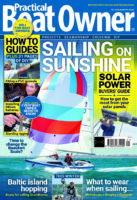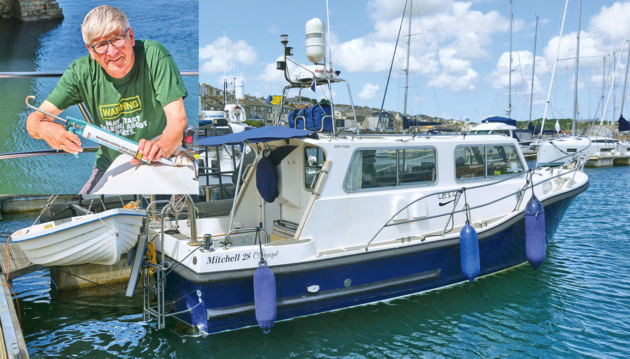Gilbert Park explains the tweaks he has made to his boat to future-proofing his time afloat
One of the few things you can be certain of is getting old and with it the decline in your abilities to manage a boat.
It is inevitable, so learning to live with and adapt to ageing will prolong the period you enjoy sailing.
Many (including me) will make the move from sail to the dark side (power boating) as the ropes get too much or being in the weather becomes too unpleasant.
Usually, this change extends the period you can still enjoy being on the water by several years, but then the progressive wearing out of your body starts to cause problems.
I’m now in my eighth decade, having been sailing for over 50 years, and I am now at this stage.
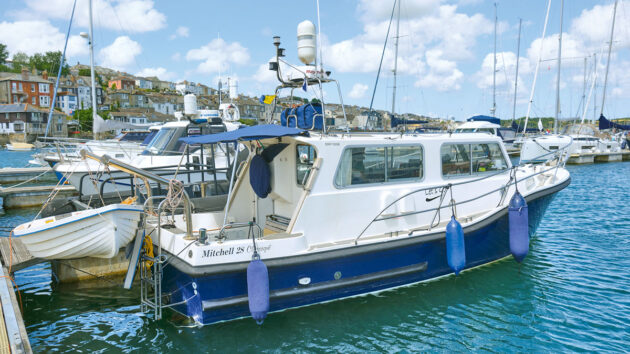
Gilbert’s Mitchell 28 has a deep cockpit, guardrails and handrails all around her non-slip deck so falling overboard is less likely. Credit: Gilbert Park
Finding ways to prolong my motor boating years has been a priority for me for some time.
Most of my focus has been on dealing with widespread, disabling arthritis. Some readers may have other medical priorities and solutions, so please share them with us.
I now have a motorboat, so this article is written with this type of boat in mind, but many of my solutions to problems are equally as useful
on a sailing yacht.
Getting old means that nearly everything deteriorates with age, the only exception, usually, being wisdom!
Because of my training as a doctor (a long time ago), I have used a systems approach to adapting to getting old.
Sight
The Mk1 eyeball remains the best navigation tool there is. Unfortunately, vision deteriorates with age, though some of this can be offset with glasses or cataract removal.
As many boaters have experienced, glasses fall off the nose into the water, so spare glasses are essential. Sunglasses may also help slow down the deterioration caused by a very bright sun reflecting off the water.
Polarising sunglasses are really good at stopping this kind of reflection, but check before buying to see if all the screens (chartplotter, autopilot etc) are visible when wearing them.
Alternatively, a pair of photochromic glasses, that become darker with bright light, may be useful, but they will always stop some light from coming through, which may limit nighttime use.
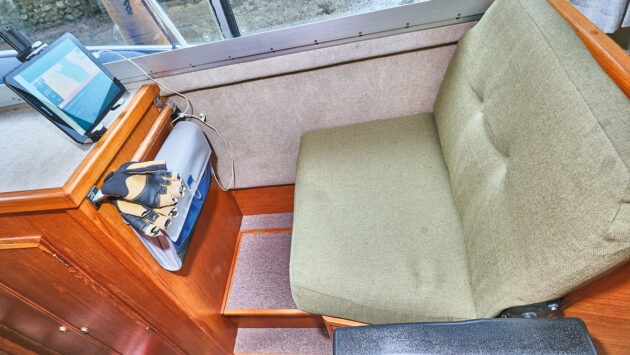
Gilbert has installed a grab handle, arm rest, small bag, rechargeable torch and a chart tablet holder at the navigator’s seat. Credit: Gilbert Park
A set of good-quality 7×50 binoculars is a Godsend. I am still amazed at how much sooner I can see buoys and other objects in the distance than with the naked eye, with the seven-times magnification.
Any greater magnification and it’s difficult to hold them steady enough (although there are now stabilised ones).
The diameter of the lens (50mm) lets in sufficient light to see clearly day and night.
Close-up work (charts, pilots etc) may be easier with a small magnifying glass.
Torches are also invaluable, even in the daytime looking down into some of the deep recesses found in boats.
I use a USE Exposure head torch more than any other sort of torch.
When first switched on, there is a dim red light (to protect night vision), and after that, you can adjust the light to give a very bright white light.
By my bunk, I have a diver’s watch with a bright luminous face so I know the time when I wake up.
Hearing
Having been completely deaf, thankfully only for a short time, I appreciate just how much information you glean from listening on a boat.
The sound of waves, the engines, and the radio are just a few of the clues about the boat’s performance.
Nowadays, many hearing defects can be ameliorated by clever hearing aids. Like glasses, spare hearing aids are needed on board, just in case they’re dropped overboard or the wearer goes over the side!
One of the things affected by even slight hearing loss is crew communication.
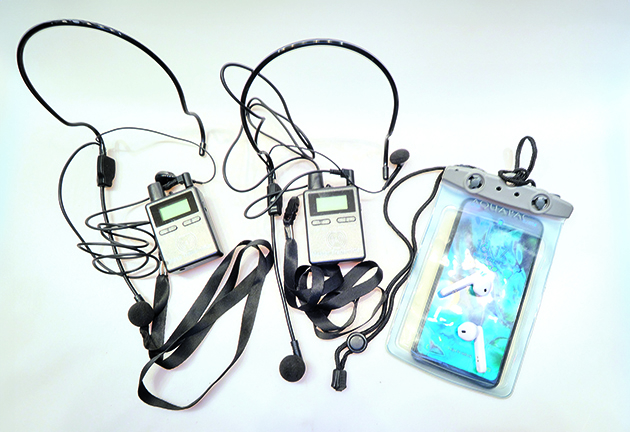
A wireless walkie-talkie or mobile phones with Bluetooth headsets can help improve communication on board. Credit: Gilbert Park
Shouting may overcome this, but this raises anxiety levels and induces a sense of panic.
This problem can be overcome by using small radio walkie-talkie sets, which enable crew to talk to each other.
An alternative is to use mobile phones, either using the cell network or connecting them using Bluetooth.
Earpiece/microphone headsets make this easy. I put my phone in a sealed, floating waterproof bag with Bluetooth headphones, just in case they disappear over the side.
I don’t use headphones for music and the like when at sea, as doing so means I can’t hear the VHF radio or things like changes in engine note.
Mental function
Although you may get wiser as you get older, other aspects of mental function get worse.
I used to have a fantastic memory for detail, but now I find I forget things. To compensate for this, I have a set of checklists.
One is an everyday checklist for things like the crew safety briefing; these live behind a lumbar cushion on the helm seat and are for me.
Next to the throttles is a red book that has all the immediate, life-threatening checklists such as Mayday and man overboard.
This is for all crew members and forms part of the safety briefing.
The third set is for other situations, such as fog and night sailing and is mostly for me.
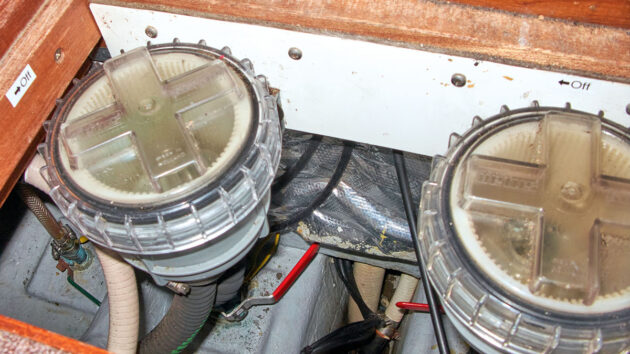
When it’s difficult to remember which way to turn the through-hull stopcocks off, labels on the bulkhead clearly show the direction for the handle. Credit: Gilbert Park
One thing I can never remember when reaching down to get at the handles of the through-hull fittings is which way to turn them off (on is easy – it’s up).
I often can’t see the actual base to look at the flange, and they are sometimes a bit stiff.
So above each one, I have put a label showing the direction for off.
The chartplotter can help with remembering when to do things.
Emptying the black water tank at sea can easily be forgotten, so I decide where on my route I plan to do this. Then I put a waypoint next to the route; I use the skull and crossbones as the image.
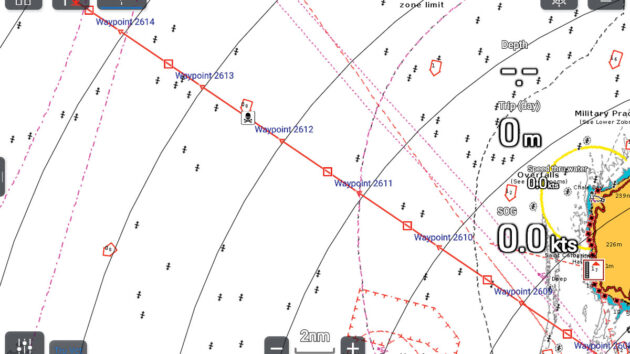
Gilbert adds a chart waypoint to remind him to empty the black water tank while at sea. Credit: Gilbert Park
You might use this to remind you to hoist the courtesy ensign and the Q flag, or perhaps to phone home.
The final part of adapting to older mental age is to automate as much as possible.
Not just the autopilot (which means you can look out of the window, instead of looking at the chartplotter), but also trim tabs/interceptors, alarms and even the fog horn to give the right signal at least every two minutes.
Use the radio and radar all the time, so if it all goes wrong, at least you are familiar with them.
Communication with shore contacts is essential to check-in when at your destination.
In the busy time of mooring up, shutting down the engines, and paying at the marina, I often forget.
I use a SPOT satellite device which sits attached to a front windscreen and has a check-in function; it does have an annual fee, but I also use it in places where there’s no phone signal, such as when crossing the Channel.
The heads
The average person flushes the toilet about five times a day. For men, this number increases with age as the prostate gland enlarges, so the heads becomes more important for older men.
Long voyages can make trips to the heads difficult, especially if you are a solo sailor.
To make life easier for men, a handle above the toilet gives a secure place to hold on while standing.
Finding a way to hold the seat up (I use a bungee strap) means that one hand can hold on, another aim and the risk of the seat and cover falling with wave action at a critical moment is averted.
The alternative, which is common on sailboats, is to ask all men to sit down when passing water.
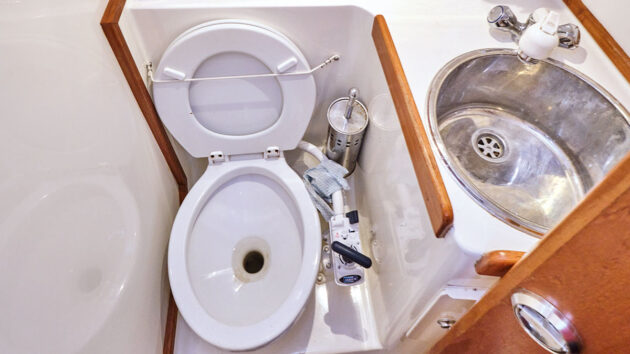
A bungee cord secures the loo seat open, and a grab handle provides security when standing. Credit: Gilbert Park
I’ve fitted a shower head that is usually found in cockpit showers, which allows cold and hot water to mix to get the ideal temperature, rather than adjusting the cold and hot water taps.
To operate it, you just need to press and hold a button. This helps reduce water use when at anchor, but you can also easily operate it while underway.
All crew appreciate nice, dry toilet paper.
As the heads on my boat is also a wet room, this was proving difficult as water was leaking in over the top of the shower door, soaking the loo paper.
I stopped it by fitting a length of plastic 1cm angle strip over the top of the door.
The final modification was to secure the door in the open position at sea. This makes it easier to get in, and the rest of the time allows it to be ‘aired’.
An alternative, which also works well, is to adopt the Navy solution to doors and just have a curtain.
Musculo-skeletal system
If there is one system that characterises getting old for me, it’s this one. Agility and, as a consequence, stability decrease with age.
Getting on the boat can be greatly helped by providing additional steps. These needn’t be fixed.
I have removable steps in the cockpit and a folding pair next to the bed.
Once you are on board, moving around at sea can be tricky, especially on deck. The most important thing about falling overboard is not to!
If someone did fall overboard, I’d find it extremely difficult to get them back on board if they were unable to use the ladder.
With this in mind, my Mitchell 28 has a deep cockpit, so the risk of falling overboard from there, by me or any crew member, is almost impossible.
The decks have a non-slip covering, and I’ve put a safety line from the stern to the bow that I can clip onto should I need to go forward.
Grab handles
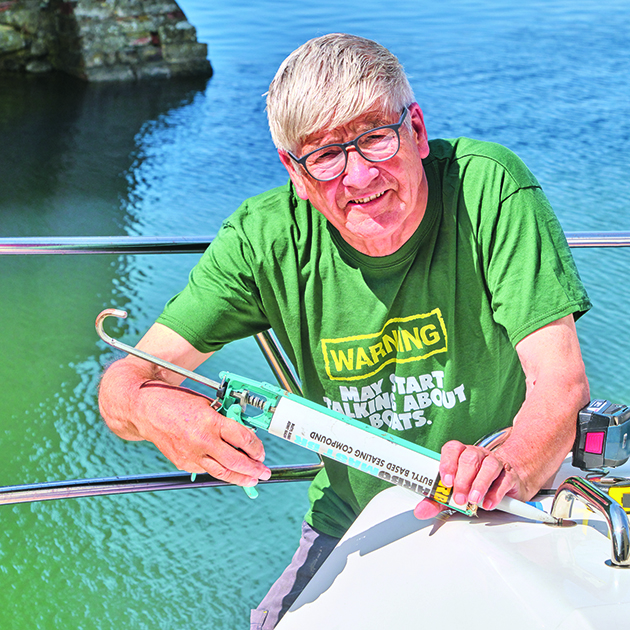
Moving around once at sea can be tricky, especially on deck, which is why Gilbert has fitted additional handrails to his boat. Credit: Gilbert Park
Handles have been installed inside and out on most boats I’ve owned.
On a Merry Fisher, handles on the lip over the front windscreen transformed safety going to and from the bow.
Inside my current boat, I have a 3m-long handle running the length of the wheelhouse. When I have visitors on board, this doubles as a curtain rail to afford privacy to the double bed that can be made up.
I have never been very strong, but as I get older, I have become weaker. I have several coping mechanisms for this.
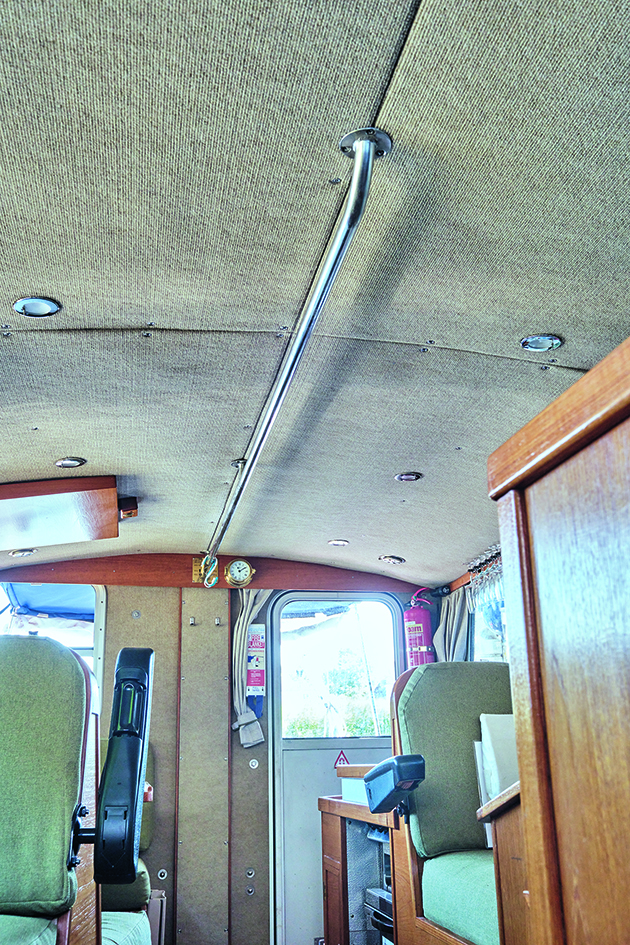
Handholds, like this long one, the length of the wheelhouse, will help with stability in a seaway. Credit: Gilbert Park
For example, when mooring the boat side-to or even stern-to, I no longer pull the boat; instead, I use forward and reverse on the engines and the bow thruster.
Thick, wet ropes are a pain (literally) to use with my arthritis, so when mooring up, I use thinner ropes that are much easier to handle. If a storm is coming, then I will double up the lines with thicker ropes.
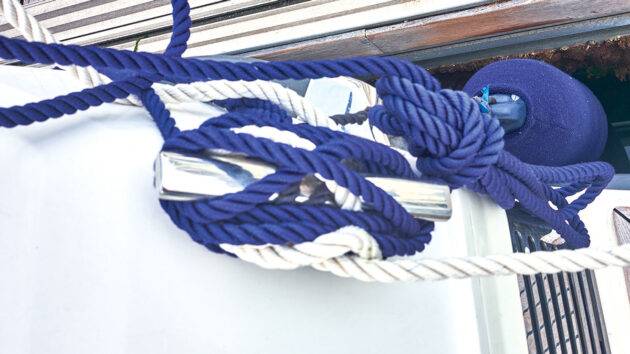
Gilbert uses thinner lines to tie over cleats as he finds it difficult to tie with thick lines due to arthritis. Credit: Gilbert Park
It may cause some comments from other boaters, because it looks untidy, but no boat I’ve secured has ever blown away.
When anchoring, again, I never move the boat by hand, always with the engine and the anchor winch.
My kedge anchor is a lightweight, aluminium Fortress anchor. I’m just about to start experimenting with the Alderney ring and a large buoy to lift this anchor.
Bend the knees
Bending the back should be avoided. Lifting deck hatches can be made easier with a simple hook of some sort clipped into the handle with a length of rope or webbing, which means you can bend at the knees and keep your back straight during the lift.
Similarly, large fenders can be stored on deck, rather than going backwards and forwards carrying them.
In the Med, when mooring stern-to, you can loosely secure the stern ropes, pick up the pendile (slime line), motor forward and secure the bow rope, then motor back and secure the stern ropes.
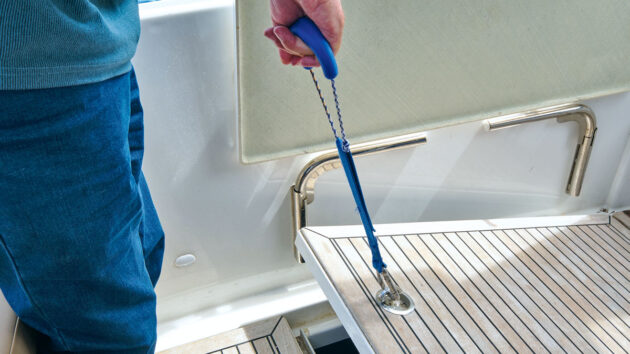
A clip and a length of rope or webbing will be enough to safely raise and lower the hatch. Credit: Gilbert Park
This avoids pulling the boat backwards and forwards by hand.
Choosing equipment that I can lift now and in the coming years is also important.
I did have a rigid dinghy at one time, but I changed that for a lightweight inflatable. Not only can I move this around the boat easily, but I can also launch it easily.
I even went so far as to buy a round-tail dinghy rather than one with a rigid transom, as it is lighter to lift and pack away.
At the helm, I have a lumbar cushion to help my back and a rear-view mirror, so I don’t have to turn my neck to keep a lookout behind.
I also keep a neck collar handy for rough weather, and in the future I’ll be fitting a headrest.
I also now modify (where possible) activities that will worsen my back, such as going out in RIBs and ploughing through waves at high speed.
I’ve discovered that if I do something that hurts my back, it may not be immediately apparent, but it takes 24-48 hours for the joints to become inflamed.
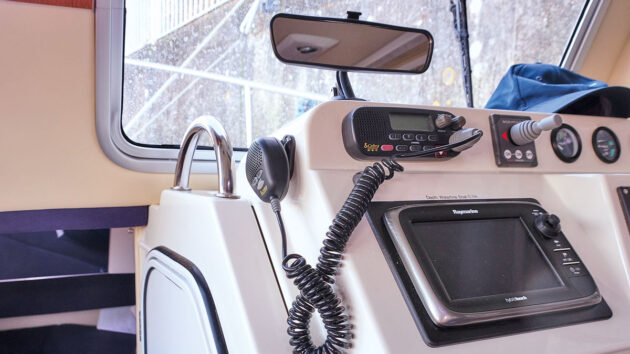
To save his neck, Gilbert fitted a rear view mirror to his Trusty T23. In some boats you may need a camera instead. Credit: Gilbert Park
So if you do develop backache, you may have to think back a day or two to work out what caused it and how to prevent it in the future.
As I write this article, I’m in the process of selling my Mitchell 28 after buying a newer Seaward 29.
One of the reasons for this change is the shock-absorbing, bouncy seats found on the Seaward.
What I hadn’t realised was that even small shocks transmitted to the spine cause damage and so pain.
Since changing boats, the backache I used to feel after a long trip has disappeared. For me, this is worth the substantial cost.
Getting in and out of a dinghy can be made easier if the dinghy is temporarily, firmly tied to the boat, bow and stern.
If the boat has a bathing platform, then the easiest way to get into the dinghy is to sit on the platform, put your legs in the dinghy and shuffle across.
The type of dinghy is also important. A hard-shell dinghy needs more care to get into than an inflatable.
I don’t have any mobility aids (yet), but their storage needs careful consideration so they are out of the way at sea, but easily retrieved for use when moored up.
Engine checks
I always do my engine checks before going out to sea. On my Mitchell, I had to lift a heavy table and then lift part of the floor, which made life difficult.
On my Seaward, you have to be a contortionist to get at the starboard dipstick. I was told not to bother about checking the oil level, but I didn’t agree.
So I got a second, easily accessible one fitted. I have seen other engines where the owner has moved the cooling water reservoir to an easily accessible place.
The afternoon nap
When I was boating in the Med, the afternoon nap was essential because of the heat.
Now that I am older, I still enjoy a refreshing short nap and find I’m not alone – my crew (slightly younger than me) often enjoys a long nap as well.
This has made me realise that there’s a risk if one of us falls overboard and the other is sleeping with the boat on autopilot – it could be miles before the loss is recognised.
So I have fitted an OLAS alarm. When I am by myself, I use the kill cord function.
Medication
Generally, as you get older, the more medication you need. One of the important things to do is to read the package insert and take it with you.
It will warn you about interactions with drugs you may not be expecting to take, such as sea sickness tablets.
Then there is alcohol – there are many myths about alcohol and medications, some true, some not. It would be a shame to avoid that end-of-the-day glass of wine or beer when you don’t have to.
Always make sure you carry a copy of your prescription on board.
Not only is this needed in an emergency, but also in case you run out of your medications or the trip takes longer than anticipated.
One of my fellow American passengers on a Rhine Cruise ran out of tablets on a Saturday evening. He then had to wait until Monday afternoon to phone and get a prescription from his doctor (in the USA).
For similar reasons, keep a copy of your prescription and a few days of medication in the grab bag.
Don’t forget to take ‘escape’ medication in case your condition gets worse. I take some powerful painkillers in case my back pain gets worse; although this would mean I couldn’t skipper the boat, I could, at least, be pain-free.
A member of your crew, often of similar age, may become ill or injured on the boat and be unable to give their medical history or drug treatment.
So all crew should be asked to provide a written medical summary that is placed in a sealed envelope and usually returned at the end of the trip.
Many times when I was practising medicine, I had to treat patients in an emergency with no idea of their medical or drug history.
This is not a good thing to do. If you are going outside of the UK, then don’t forget health insurance.
Medical care abroad, even for relatively minor things, can be very expensive once radiology, laboratory tests and medication are added to medical and nursing care.
I did once have a taxi prescribed by the hospital to take me back to my boat after a night in the hospital (plus CT scans).
To my surprise, because it was prescribed, the insurers coughed up for it.
Survival
If a survival situation develops, then the elderly do less well than younger crew members. It’s important to realise this and take sensible precautions.
The first and most important thing to do is to wear a lifejacket outside of the cabin.
I wear one inside the cabin as well, and will be writing more about why I do this and the precautions I take in the future.
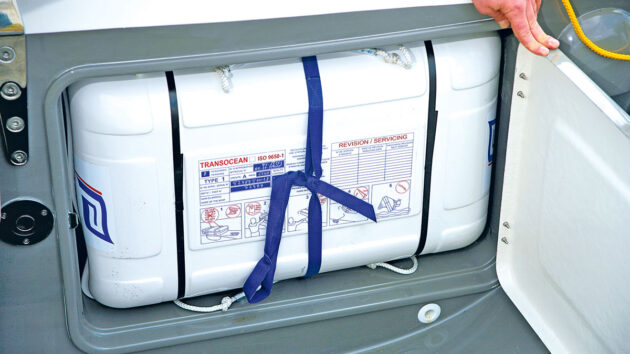
Think about where you store your liferaft so you can easily move it for deployment. Credit: Graham Snook/Future
I do have a liferaft, even though I mostly sail around the south coast of England. There is debate over the need for this.
However, many of the discussions about liferafts don’t take into account age, so I have one.
One of the important things about liferafts is weight. A six-person liferaft stored in a locker is too heavy for me to lift out of the locker, so I have a liferaft in a valise stored on the roof of my boat, where I can easily access it and use gravity to help me launch it.
Realism
As I have got older and more limited in my mobility, I’ve had to rein in some of my more ambitious plans.
Just before the first Covid-19 lockdown, I did my Ocean Yacht Master theory course.
During the first lockdown, I planned the practical in great detail. Part of the requirements was a 600-mile journey with at least 200 miles being 50 miles offshore.
My friend, James, agreed to accompany me, and then Covid-19 went on and on, and then there was Brexit.
By the time it was becoming possible to do this trip, I was older, and my arthritis was worse. So I’ll have to live without my full Ocean Yachtmaster.
You also need to be realistic about what size of boat you can manage.
Large boats can now be managed easily with the advent of bow-thrusters and stern-thrusters, joysticks, remote controls and cameras.
A simpler solution I have used is proportional bow-thrusters and stern-thrusters that not only move the boat sideways, but also can be set to pin the boat against the dock while lines are put on.
Flybridge boats may be more difficult because of the steps and stairs.
DIY – how to continue
Someone once said everything on a boat is broken, you just don’t know it yet! One thing PBO readers enjoy is fixing their boats.
As you get older putting screws into hard-to-access places, or putting a small nut onto a bolt gets difficult.
The first thing to remember is that you will drop parts like this more often than you used to.
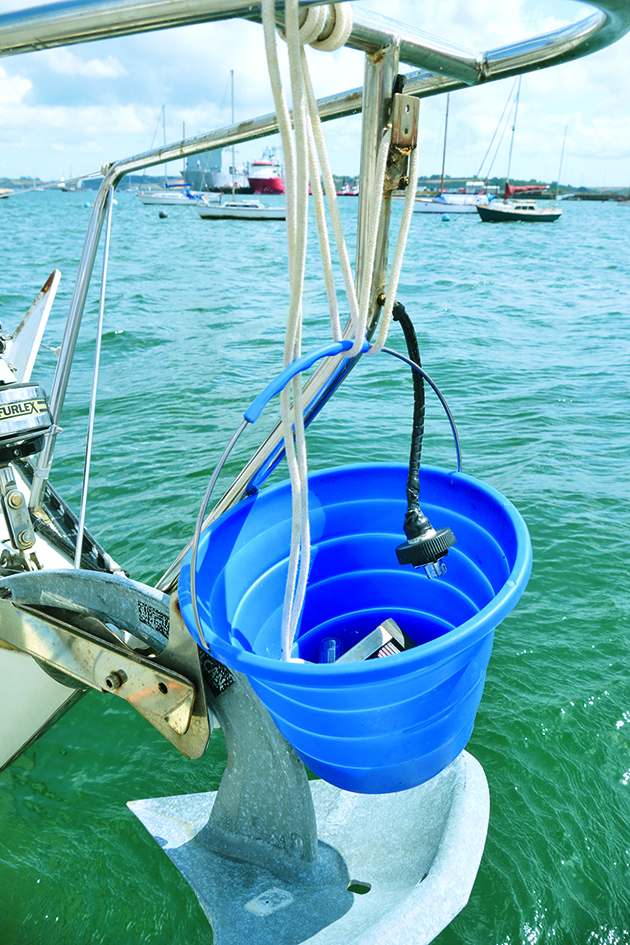
Working with a bucket when doing repairs over the sea improves the chances of anything dropped being caught. Credit: Gilbert Park
So, place an old towel underneath where you are working. If the part does fall, then it won’t bounce off into the bilge. If you’re working over water, a bucket or an upturned umbrella placed underneath will stop the part from falling into the water.
Prevention being better than cure, it may be better to use things such as finger nut holders, screw holders, nuts with washers already fixed to them etc.
If you are using cable ties, forget the small ones and use larger ones that are much easier to hold and cut.
The correct tools are also important. I find the small wrench that holds hexagonal bits invaluable in confined spaces.
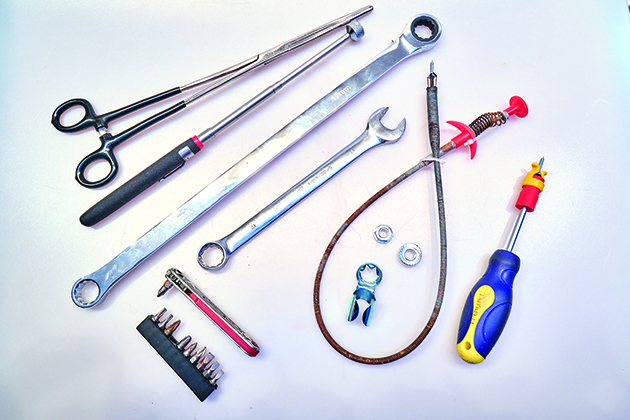
Difficulty getting into tight areas for fixings can be eased by having the right tools – things like long surgical forceps, a magnet on a telescopic stick, and extra-long spanners. Credit: Gilbert Park
Make sure you have the right bit, a Phillips screw bit doesn’t properly fit a Pozidriv head and is more likely to slip, damaging the screw.
I also have several sets of spanners, including an extra-long set. I use these for two reasons.
The first is that I have grown weaker with age, and a long spanner gives me more leverage.
The second is when I have to reach down into a small space to tighten a nut.
On one occasion, I was tightening the nuts on the starboard stern seal. To gain access, I had to empty a locker and remove its floor.
Reaching down to get at the seal, I toppled into the locker, with my head jammed upside down against the exhaust tubing.
I was on my own, trapped. I could raise no one by shouting, and my phone was up top.
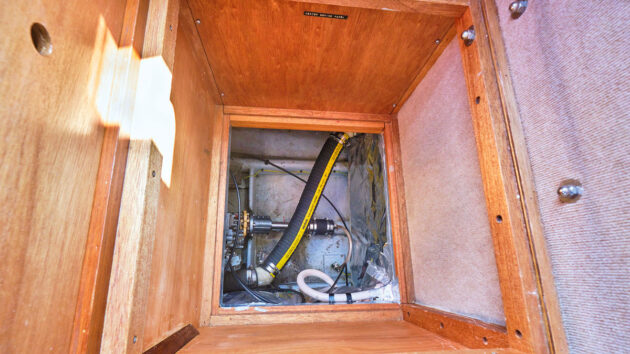
Gilbert was temporarily trapped upside down in the locker while accessing the starboard stern gland to tighten the seal nuts. He now uses extra-long spanners for this type of work. Credit: Gilbert Park
Eventually, after a struggle, I was able to turn myself the right way around and get out, somewhat shaken.
With longer spanners, I don’t have to reach so far and indeed may be able to get access from elsewhere.
Should something fall into the bilges, I have a grabber and a very long pair of surgical forceps, which I bought cheaply at a street market.
I also have a magnet on a stick, again from a market, to pick up anything that falls in, although many of the nuts etc, are stainless steel and not magnetic.
Finally, if you live in the UK, there is an item you must get – the free bus pass.
Don’t forget to take it with you on a trip and enjoy exploring the area around the boat.
After that, keep taking the vitamin pills and eat five portions of fruit and vegetables a day!
Want to read more articles like Never stop sailing! Practical ways to make it easier as you age?
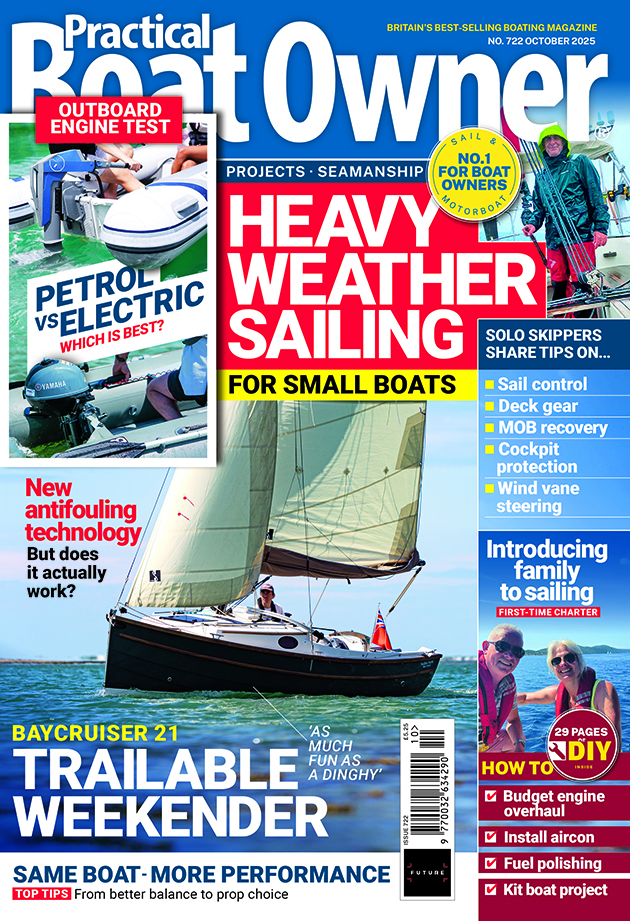
A subscription to Practical Boat Owner magazine costs around 40% less than the cover price.
Print and digital editions are available through Magazines Direct – where you can also find the latest deals.
PBO is packed with information to help you get the most from boat ownership – whether sail or power.
-
-
-
- Take your DIY skills to the next level with trusted advice on boat maintenance and repairs
- Impartial, in-depth gear reviews
- Practical cruising tips for making the most of your time afloat
-
-
Follow us on Facebook, Instagram, TikTok and Twitter

